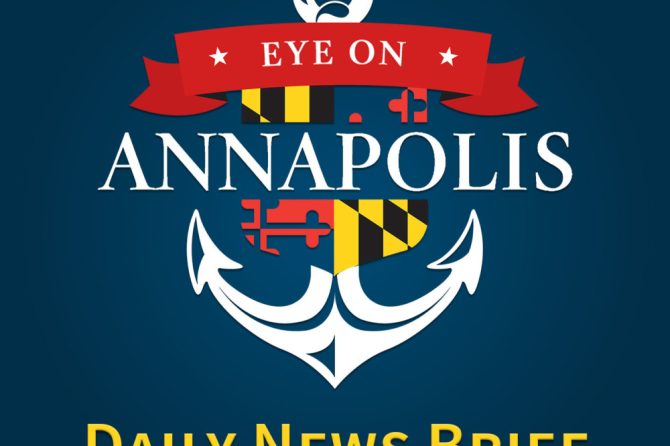
 Governor Larry Hogan and Lt. Governor Boyd Rutherford recently joined with the Department of Health and Mental Hygiene Secretary Dennis Schrader, Governor’s Office of Crime, Control, and Prevention Executive Director Glenn Fueston, Anne Arundel County Executive Steve Schuh, Anne Arundel State’s Attorney Wes Adams, and Anne Arundel Medical Center President Victoria Bayless at the Anne Arundel Medical Center to announce the administration’s 2017 Heroin and Opioid Prevention, Treatment, and Enforcement Initiative, a multi-pronged and sweeping administrative and legislative effort to continue addressing Maryland’s ongoing opioid and heroin epidemic.
Governor Larry Hogan and Lt. Governor Boyd Rutherford recently joined with the Department of Health and Mental Hygiene Secretary Dennis Schrader, Governor’s Office of Crime, Control, and Prevention Executive Director Glenn Fueston, Anne Arundel County Executive Steve Schuh, Anne Arundel State’s Attorney Wes Adams, and Anne Arundel Medical Center President Victoria Bayless at the Anne Arundel Medical Center to announce the administration’s 2017 Heroin and Opioid Prevention, Treatment, and Enforcement Initiative, a multi-pronged and sweeping administrative and legislative effort to continue addressing Maryland’s ongoing opioid and heroin epidemic.
The administration’s 2017 Heroin and Opioid Prevention, Treatment, and Enforcement Initiative includes the creation of a statewide Opioid Operational Command Center to assist in breaking down governmental silos and to aid in the coordination of federal, state, and local resources. In addition to $4 million new funding, three new pieces of legislation are also being proposed: the Distribution of Opioids Resulting in Death Act, the Prescriber Limits Act, and the Overdose Prevention Act.
“Marylanders from one end of the state to the other know the devastation that heroin and opioid abuse can cause,” said Governor Hogan. “It’s under the surface of every community, and we decided we were going to shine a spotlight on this, to try to find as many possible solutions as we could. Today, we are announcing our 2017 Heroin Treatment, Prevention, and Enforcement Initiative, because as this crisis evolves, so must our response to it.”
“The reality is that the heroin problem in Maryland has changed with the emergence of cheap and potent synthetic opioids, which pose a new threat to our communities,” said Lt. Governor Rutherford. “The Governor and I look forward to working with members of the legislature to enact these common sense proposals, as we continue to use all the tools at our disposal to address this crisis and to save lives.”
Since forcefully recognizing and identifying the rapidly growing opioid and heroin epidemic three years ago during the 2014 gubernatorial campaign, Governor Hogan and Lt. Governor Rutherford have made proactively addressing this crisis a cornerstone of the administration’s agenda.
In 2015, Governor Hogan signed an executive order creating the Heroin and Opioid Emergency Task Force, chaired by Lt. Governor Rutherford. The Task Force developed 33 recommendations to aggressively combat the opioid and heroin crisis. The recommendations focused on prevention, treatment, and enforcement. Examples of recommendations of the Task Force that have been implemented by the administration include:
- Through the Substance Abuse and Mental Health Services Administration, the Department of Health and Mental Hygiene issued a final rule to increase the number of patients that qualified physicians who prescribe buprenorphine for opioid use disorders can treat from 100 to 275.
- Recognizing the importance of partnering with local jurisdictions, the administration funded 18 county-level heroin coordinators to promote an integrated law enforcement approach and to gather, analyze, and share actionable information, making it easier for law enforcement to identify drug traffickers.
- As part of the Justice Reinvestment Act, the state passed the Racketeering Influenced and Corrupt Organizations statute to make it possible for the prosecution of major drug traffickers that operate across jurisdictional lines.
- Expanded the Prescription Drug Monitoring Program by requiring mandatory registration for all providers that have a license to prescribe or dispense controlled dangerous substances and requires certain providers to check the program database before prescribing an opioid or benzodiazepine.
Along with much of the nation, Maryland is experiencing the emergence of a new threat in the form of potent and cheap synthetic opioids, such as fentanyl. Deaths related to fentanyl have risen dramatically in the state, as the drug is 80 times more potent than morphine, approximately 40 to 50 times stronger than street-level heroin, and is being mixed with heroin to increase its potency. In addition, carfentanil, an opioid analog with no medical purpose in humans, was responsible for spikes in fatal overdoses in Ohio and West Virginia over the summer, and has more recently been confirmed in Northern Virginia.
To continue addressing the growing problems of the opioid and heroin addiction epidemic as well as the new threat of synthetic opioids, the Hogan administration is announcing new legislative and administrative actions, supported by new budgetary commitments:
Opioid Operational Command Center:
Governor Hogan today signed an Executive Order amending the 2015 Executive Order to establish the Inter-Agency Heroin and Opioid Coordinating Council, authorizing the council to establish the Opioid Operational Command Center. The center will facilitate greater collaboration between state and local public health, human services, education, and public safety entities to reduce the harmful impacts of opioid addiction on Maryland communities. As a direct result from increased collaboration, the center will collect and collate data – data that will be used to save lives.
The Opioid Operational Command Center will be a collaborative effort working directly with both local and federal organizations and agencies, as well as 12 state agencies and departments including: the Governor’s Office of Crime Control & Prevention; Department of Health and Mental Hygiene; Maryland Emergency Management Agency; Maryland State Police; Maryland State Department of Education; Department of Human Resources, Department of Juvenile Services; Department of Public Safety and Correctional Services; Maryland Institute for Emergency Medical Services Systems; Maryland Higher Education Commission; Maryland Insurance Administration; and the Office of the Attorney General.
The center will be tasked with organizing and coordinating resources to local Opioid Intervention Teams. These local teams will receive training though the center.
The creation of the Opioid Operational Command Center builds and expands on a recent Hogan administration announcement to provide $931,371 in funding for heroin coordinators in law enforcement agencies in every region of the state and $2,070,397 in funding for nine jurisdictions to continue the Safe Streets Initiative, an offender-based program that tracks down and arrests the most serious and violent, repeat offenders while connecting those offenders struggling with substance abuse to drug treatment, health care, education, and other services.
Treatment
Governor Hogan’s proposed fiscal year 2018 budget includes $4 million in new funding to bolster the state’s efforts in supporting those struggling with heroin and opioid addiction. In addition, the budget contains $1.3 billion for mental health and substance use disorders, including $159 million dedicated to existing non-Medicaid substance use disorder treatment programs. Last year, the administration increased the budget for treatment beds for substance abuse patients, an increase of over 50% over the previous administration. The current budget sustains that increase.
In addition, the Maryland Department of Health and Mental Hygiene recently applied for and received a Medicaid Waiver renewal for its HealthChoice Program. This will allow Maryland Medicaid to reimburse for residential substance use treatment services delivered in large facilities, known as Institutes for Mental Diseases, greatly expanding the number of facilities in Maryland that can offer treatment services.
This waiver will also authorize the state to pursue presumptive eligibility for individuals leaving jail or prison through its Medicaid State Plan. In the weeks ahead, the state will amend its Medicaid State Plan to create this eligibility option, which will supplement Maryland Medicaid’s current jail enrollment and care coordination strategy.
Enforcement
The administration will continue to partner with local, state, and federal law enforcement to target the drug traffickers that profit from addiction and will provide additional tools for prosecutors to hold drug traffickers accountable:
Distribution of Opioids Resulting in Death Act:
This legislation will create a new felony, punishable by up to 30 years, for individuals who distribute an opioid or opioid analog, of which the use causes the death of another. The legislation contains an important provision to allow prosecutors to target kingpins. Additionally, the legislation contains protections for those who sell drugs to support their own addiction.
Prevention
The Department of Health and Mental Hygiene will propose two pieces of legislation aimed at preventing addiction from taking root and ensuring that if addiction does develop, that proper means are in place to prevent overdoses from becoming fatal.
Prescriber Limits Act:
This legislation would limit the duration of prescription opioids prescribed upon the initial consultation or treatment to a 7-day supply, except for when the opioid is prescribed for the treatment of pain associated with a cancer diagnosis or a terminal illness, or to treat a substance-related disorder. During the past year, a number of states, including New York, Massachusetts, and Arizona, have moved to limit the amount of opioids that can be prescribed, and the Centers for Disease Control and Prevention (CDC) is a strong supporter of duration and dosage limits.
Overdose Prevention Act:
This legislation will authorize local fatality review teams to review non-fatal overdose data in addition to the fatal overdose data they currently review in order to: recommend overdose prevention strategies; expand access to naloxone prescriptions directly from a pharmacist without the current training requirements and extend current immunity provisions to pharmacists; and allow and make more efficient the ability of the Department of Health and Mental Hygiene’s Office of Controlled Dangerous Substances Administration to take action against the CDS registration of a prescriber or dispenser of controlled dangerous substances based on investigations of the federal Drug Enforcement Administration or a state professional licensing board.
- MD Governor's Office









































